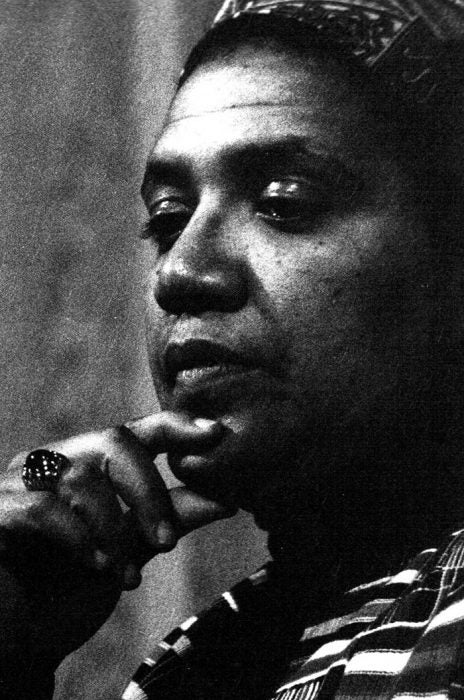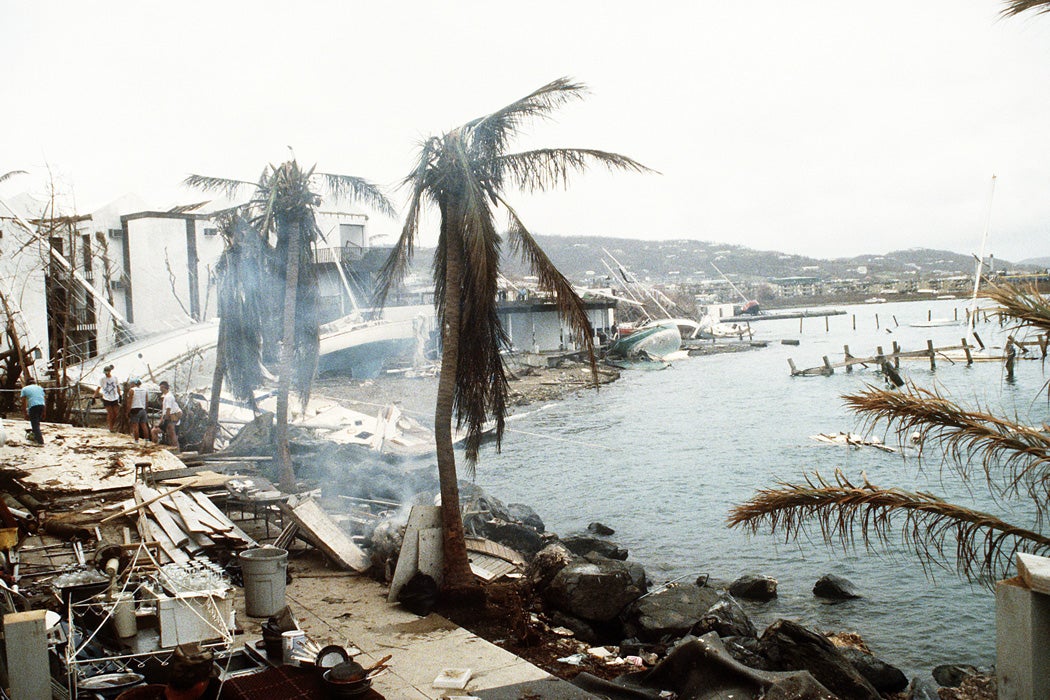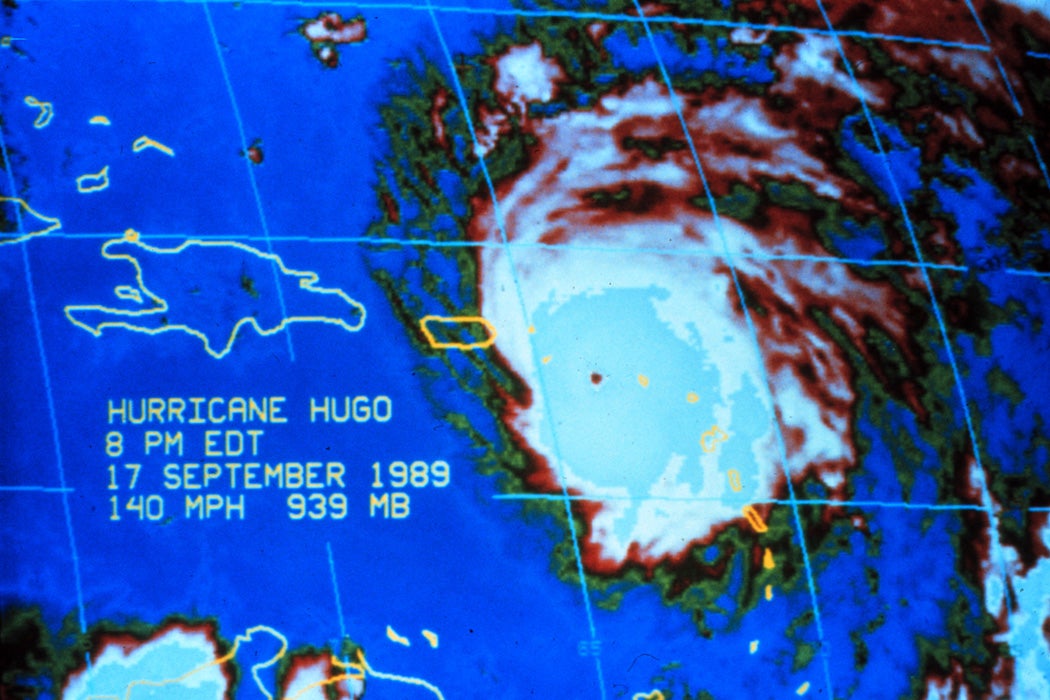Three years before the celebrated author, poet, and scholar Audre Lorde passed away from breast cancer, she survived what was, at the time, one of the most catastrophic hurricanes to occur in the Atlantic Ocean. The tiny Caribbean Island of St. Croix, where Lorde had been living, was directly in the eye of Hurricane Hugo, a Category 5 storm that wreaked havoc on the U.S. Virgin Islands in 1989, before eventually making landfall in South Carolina.
“We were lucky,” Lorde wrote in a series of letters shortly after the storm hit as she surveyed the scene: upturned groves of coconut trees, damaged buildings and homes, flowers and bushes shredded by the winds. “There is little time to think about anything other than physical safety and survival. We have stepped out into a world forever altered.”
In the months that followed, she chronicled the man-made disaster that followed the natural one in St. Croix, a U.S. territory. Her thoughts were published as a series of letters in Callaloo. The soldiers and U.S. Marshals who initially arrived on the island brought their M-16 rifles with them, but no emergency relief supplies. They did so knowing that there was no running water, no electric power, and no phone lines to serve the island’s 55,000 residents. It began to feel, Lorde wrote, more like an invasion than disaster relief.
“Obviously, the first and primary mission of the U.S. military upon arrival is to protect property,” she said. “No matter what. Drawn guns barring the road to the airport. Drawn guns protecting the road to Hess Oil, a private company with government contracts.”

The island’s high poverty rate, higher than the mainland United States’, was apparent in the aftermath of the storm. National media, from the Chicago Tribune to the Washington Post, picked up on images of mostly black residents “looting” from white owned shops. What goes unsaid, however, is the fact that low-income islanders were hit the hardest. Their homes, which one post-storm analysis described as “‘do-it-yourself’ types of wood construction” were hit the hardest. Residents had no fresh water, dwindling supplies of food, and no electricity or phone lines to call for help.
As a remedy, the federal government sent in federal troops to stop the so-called lawlessness. Yet it would be months before the Federal Emergency Management Agency finally sent roofing and other supplies to the island’s residents. Those left homeless by the storm were left to fend for themselves and continue waiting. By that December, three months after the hurricane hit, Lorde recounted that there was no power on the island, no phone lines, and no permanent roof over her head.
“We are a territory of the most powerful country on earth, supposed to be,” Lorde wrote. “Why are there almost 700 families still homeless? If we do not learn the lessons of Hurricane Hugo, we are doomed to repeat them. Because Hugo will not be the last hurricane in this area.”
* * *
In the thirty years since Hurricane Hugo made landfall in the Caribbean, it’s been outranked as the most expensive natural disaster by more than a dozen storms. Stronger hurricanes are a reality of climate change: They are one of the many impacts already observable in a hotter world. Warmer air and warmer water currents intensify precipitation and wind speeds, leading to more destructive hurricanes.

A recent study from Nature Communications found that climate change accounts for the increasing number of storms that rapidly intensify from milder Category 1 storms to Category 4 or 5. The occurrence of these types of storms tripled during the years covered by the datasets, from 1982 to 2009. The same conditions—warmer ocean water and air currents—that feed stronger storms overall also cause them to intensify faster.
A 24-hour window—or less—is hardly enough time to evacuate or prepare for a Category 5 storm. Ahead of Hurricane Harvey descending on Houston in 2017, the mayor refused to issue a mandatory evacuation order. There was no feasible way, city officials later said, to evacuate more than 2 million residents ahead of the hurricane making landfall. Doing so might have stranded families on highways in traffic jams, a more dangerous situation to be in as floodwaters rise.
If the emergency response ahead of a natural disaster is difficult to coordinate on the mainland, where resources and regulations are generally easier to come by, the difficulties of storm preparation are exponentially greater for island territories. There are no roads to drive off an island, after all.
After Hurricane Maria struck Puerto Rico, it was initially estimated that 64 people lost their lives during the storm. But six months later, a study from the George Washington School of Public Health estimated the real death total at nearly 3,000 people. Many of those deaths occurred not immediately after the storm but in the weeks and months that followed, as the island struggled to repair its broken power grid. It took nearly a full calendar year for electric power to reach all the island’s residents, who had in the meantime been living without refrigerators, air conditioners, or any of the appliances taken for granted in the twenty-first century.
Puerto Rico’s Center for Investigative Journalism reported that sepsis—a normally treatable condition that occurs when your body can’t fight off infections like the flu or pneumonia—was the eighth leading cause of death in a ten-month period after Maria struck. The disparity in disaster relief funding for states and U.S. territories is stark: According to one analysis, survivors of Hurricanes Harvey and Irma, which struck the Florida coast in 2017, received nearly $100 million dollars from the Federal Emergency Management Agency within nine days of the respective storms. In the same span of time, survivors of Maria had received only a little over $6 million.
When Lorde wrote in 1989 that Hugo would not be the last disaster of its scale in the Caribbean, she was pointing to the man-made as much as the natural. Lorde saw that her island home—predominantly black, low-income, and without the privileges of statehood—was demonized by the press and by the government in the aftermath of the storm, the victims blamed for their own suffering.
She watched development funds go to hotels first, and to Hess Oil, which operated a facility that was, at the time, the largest oil refinery in the Western hemisphere. It was built on St. Croix largely because of lax environmental regulations and financial incentives. It leaked hundreds of thousands of gallons of oil after it was damaged in the storm.
In 2017, Puerto Ricans and Virgin Islanders witnessed more of the same: Seven months after Maria swept through, American millionaires using the island as a tax haven had returned to its fully functional resorts and private beaches, which were patrolled by private security firms.
“We are a territory,” Lorde told the editor of the black literary journal Callaloo in a 1990 interview, reflecting on the aftermath of Hurricane Hugo. “[W]hich is a polite word for a colony.”
In the relationship between colonizer and colonized, the former holds power. The Caribbean islands were first subject to colonial rule with the arrival of the Spanish, and their systems of slavery and exploitation, in the fifteenth century. But the history of this region goes back further, and a long tradition of indigenous knowledge existed before colonization. The indigenous people of these ecologically sensitive islands had developed sophisticated understandings of how hurricanes formed—and how to predict landfall. The historian Stuart Schwartz writes that the Taino recognized, for example, that hurricanes had rotating winds—a fact that wouldn’t be established in European sciences until the nineteenth century.
Yet native knowledge of dangerous storms was often discounted entirely by the Europeans. Their supposed ignorance was seen as further justification for the civilizing mission: Natives were accused of sorcery and devil worship when they accurately predicted hurricanes three or four days out. The very knowledge that had empowered indigenous communities to understand and survive in their sometimes-hostile environment was weaponized against them.
Once a Week
Hurricanes have occurred annually in this portion of the Atlantic for as long as written records exist. It is only the scope of the damages—to private property on vulnerable coastlines, and infrastructure that can’t withstand winds and storm surges—that is a product of modern capitalism. It was these man-made forces that Lorde critiqued in her letters, not the predictable cycle of the winds and water currents that have existed for centuries.
“Nature heals herself,” Lorde wrote. “The earth is telling us something about our conduct of living, as well as about our abuse of this covenant we live upon.”













